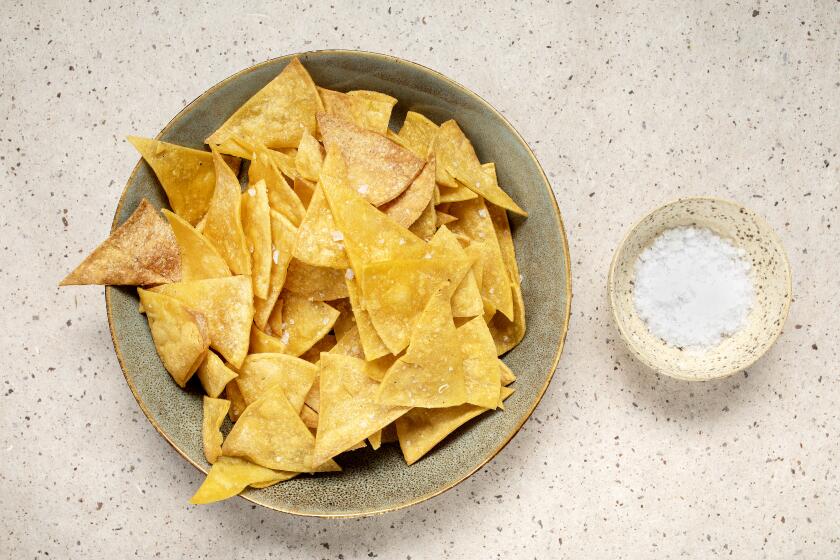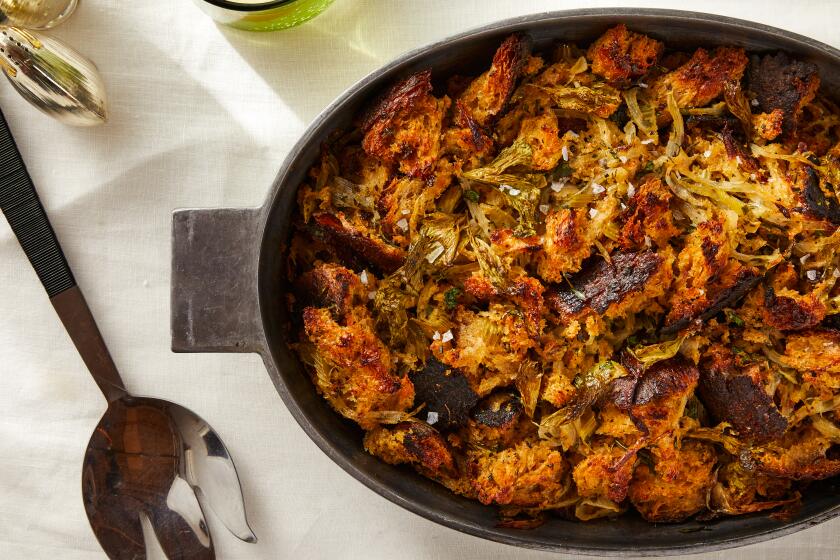Nancy's basic focaccia dough
We’ve all been there. You’re in a foreign country, or a favorite restaurant here in town, eating something that you just love and wondering, maybe even worrying, “How will I ever make this at home?” That’s exactly what happened to me a few summers ago, on a trip to Matera, in southern Italy, when I tasted the area’s signature tomato-and-roasted-pepper-topped focaccia.
Until then, I was not a fan of focaccia. Here in Los Angeles, those dense, cake-like squares of dry, flavorless bread, topped with rosemary if you were lucky, always seemed like a bad cliche -- something Italian American restaurants offered for their bread service as a way to appear authentic or simply to stick with a theme.
But I wanted to love focaccia. And when Joe Bastianich, who is a partner in Mozza and an Italian cuisine aficionado, asked me, “Why do you think nobody can make it here like it’s made in Genoa and Puglia?” it wasn’t long before I planned a trip to find out what he had in mind.
My optimism was justified that day in Matera. This one was moist and chewy, with an irregular hole structure and an oily, crunchy underside. The bread was delicious -- slightly sour and yeasty -- and the toppings were just a bonus. It was like a cross between really good bread and really good pizza, and it was love at first bite. All I had to do was copy it.
Fortunately, figuring out how to re-create foods, or my versions of them anyway, is my strength. I did it with bread after tasting the loaves baked by Acme Bread Co.; I did it with Oreo cookies, my guilty pleasure; I did it with pizza, using Chris Bianco’s crust as my inspiration; and now I’ve done it with focaccia.
A lot of home cooks believe there are professional secrets to how certain foods are made, but what I have learned is that more often than not, the steps or ingredients that make a dish special -- whether it’s gelato, ragu Bolognese or, in this case, focaccia -- are far simpler than we might imagine.
These techniques are usually not carefully guarded secrets. Particularly when it comes to rustic Italian cuisine, it’s often just a matter of finding out how something is traditionally done and making adjustments from there. The advantage pros have over most home cooks is experience to draw on. To replicate my Italian experiences of focaccia, I was able to use my knowledge of bread making.
But the other thing I did, which anyone can do, is observe very carefully.
It’s the little things
My first clues came when I visited a panificio, or bakery, in Conversano, in Puglia. Although I wouldn’t be completely sold on focaccia for a few more days, I liked what I had there enough to ask if I could peek in the kitchen, where I saw three things that would change my focaccia-making world.
First, I saw that the focaccia was baked in a round cake pan. Until then, I had always baked focaccia in large rectangular sheet pans. But after seeing it baked in cake pans, I realized that by working with such an unwieldy lump of dough, I had been mishandling it and thereby taking the air out of it, which makes for a dense bread. Using the smaller pans means working with dough in a more manageable size and shape .
I also saw that the baker was cutting the dough into portions, immediately putting each in the pan in which it was going to be baked, and then leaving it there to relax for its second rise. This eliminated the step of shaping the dough in the pan, which, again, would make for a denser bread.
The third and maybe most significant thing I saw was that the cake pans had olive oil in them, and not just enough to coat the pan but a layer 1/8- to 1/4-inch deep. It was a substantial enough amount that the oil would be absorbed into the bottom crust, making it crunchy and flavorful.
Less than five minutes in this baker’s kitchen, without asking a single question, and my focaccia had already improved exponentially.
When I got back to the Mozza kitchen and attempted to replicate that focaccia, I had only to work on the dough, which was the easy part. The more I experiment, the more I have come to see that all yeasted breads are more or less variations on a formula of flour, water, salt and yeast. I start with that basic formula and, because of my understanding of how bread and yeast works, I am able to tweak a few things to obtain whatever dough I want.
Working the dough
For this focaccia, I knew that I wanted it to be light with a lot of air holes, so I decided to start with the dough I use for a classic country white bread and go from there. There are different ways to achieve the air holes that I wanted, but the way I did it is to use a sourdough starter.
But since I assume that the average Angeleno does not keep a sourdough starter at home, for this article I have created a quick overnight starter, called a sponge. This not only gives me the light bread with the irregular hole structure that I want, but it also imparts the mild fermented, sour flavor that I want for the focaccia.
I also knew that to get those holes, along with the moist, chewy texture that I wanted, I needed to have a very wet dough. The method that I have used over the years in working with a wet dough is to fold the dough in the middle of its proofing time. Folding the dough strengthens it and makes it easier to handle; without this step, it will ferment too quickly and collapse.
After making the dough, the next step in making focaccia is to dimple. In the past, when I’d made focaccia, I had found that the dimples almost disappeared when it was baked. But in Italy, I noticed that the ingredients are not laid on top of the dough, which would make the focaccia heavy and one-dimensional. Instead, the toppings are pushed deep into the dough, so the bread bakes up around them. Not only does this make the focaccia really interesting to look at, it also results in a bread that is light-textured.
At Mozza when we press the toppings into the dough, we push ever so slightly outward, toward the edge of the pan. In so doing, we are killing three birds with one stone: embedding the topping into the dough, dimpling the dough and encouraging the dough toward the edges of the pan.
Baking the focaccia turned out to be almost foolproof. Having it in the cake pan, and having the oil in the cake pan, already eliminates so many of the potential pitfalls of focaccia. And unlike when you are working with pizza or bread, it is not essential to have a super-hot oven. Though as with pizza, I found that baking it for a short time directly on the floor of the oven helps to create the crispy, crunchy underside.
If you’ve never baked yeast breads before, this focaccia is a good, safe place to start -- first because you have a very high probability of beautiful, delicious results, and second, because unlike a good loaf of bread, which you can now get in many grocery stores in Los Angeles, unless you go to southern Italy, Genoa or Mozza2Go, there is only one way to get good focaccia, and that is to make it yourself.
For better or worse, there just aren’t many things you can say that about anymore.
Focaccia sponge
In a small mixing bowl (preferably plastic or ceramic), sprinkle the yeast over the water. Set the bowl aside for a few minutes to give the water time to absorb the yeast. Using a wooden spoon, stir in the bread flour until all of the ingredients are thoroughly combined.
Cover the bowl tightly with a sheet of plastic wrap, then tightly wrap another piece of plastic wrap or twine around the perimeter of the bowl to further seal the bowl.
Set the bowl aside at room temperature (ideally 68 to 70 degrees) until the sponge becomes bubbly and thick, like the consistency of wallpaper paste (thicker than a pancake batter but thinner than dough), 12 to 24 hours.
Focaccia dough
About 3 1/2 hours before you are ready to bake the focaccia, place the water, scant tablespoon olive oil and sponge in the bowl of a stand mixer. Fit the mixer with a dough hook and, over low speed, add the yeast, rye flour and 15 ounces (3 1/3 cups) bread flour. Mix the ingredients over low speed for 2 minutes to thoroughly combine and form the dough.
With the mixer running, slowly add the salt, then increase the speed to medium. Continue mixing the dough until it is smooth and well-formed, and starts to pull away from the bowl, 6 to 8 minutes. Note that the dough will not pull so much that it “cleans” the bowl, but if the dough is too sticky and is not pulling away from the sides of the bowl at all, add a little more bread flour (a spoonful as needed at a time) to achieve the right consistency.
While the dough is mixing, lightly grease a bowl large enough to hold the dough when it doubles in size with olive oil. When the dough is ready, turn it out of the mixer into the oiled bowl. Wrap the dough tightly in plastic wrap and tightly wrap the perimeter of the bowl with kitchen twine or another piece of plastic wrap to further seal the bowl. Set the dough aside at room temperature (ideally 68 to 70 degrees) until doubled, about 1 1/2 hours.
Dust the work surface lightly with flour and turn the dough out onto the floured surface. Acting as if the round has four sides, fold the edges of the dough toward the center. Turn the dough over and return it, folded side down, to the bowl. Cover the bowl again with plastic wrap and set it aside at room temperature until it has doubled in volume, 50 minutes to 1 hour. (The dough will be puffy and will feel alive, springy and resistant. It will not collapse under the touch of your fingertips.)
Pour 1/4 cup olive oil into each of the cake pans, and tilt the pans so the oil coats the bottom evenly. Dust the work surface again lightly with flour and carefully turn the dough out onto the floured surface, taking care not to deflate the dough in the process. Divide the dough into two equal segments, each weighing approximately 18 ounces. Place the dough segments in the prepared cake pans and very gently pull the edges just to obtain a roughly round shape. Cover the pans with a clean dishcloth and set aside at room temperature until relaxed and spread to cover about half of the surface of the pans, about 30 minutes.
Get our Cooking newsletter.
Your roundup of inspiring recipes and kitchen tricks.
You may occasionally receive promotional content from the Los Angeles Times.















